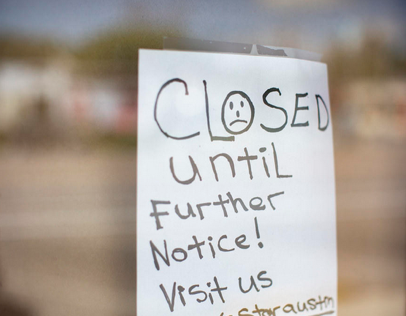Like other small businesses throughout North Carolina, child care programs have been hit hard during the COVID-19 public health emergency. As of April, about half of the child care programs statewide had closed.[1] For the half of programs that were open, enrollment of children was far below prior levels upon which the child care business model was based.
For example, in April, among the 53 percent of child care centers that were open, centers reported average vacancy rates of 68-70 percent of capacity.[2] Among the 88 percent of family child care homes that were open at that time, average vacancy rates ranged from 37-41 percent.[3]
Prior to COVID-19, about 41,000 teachers and staff worked in child care.[4] In April, 20,000 child care staff were working on-site, indicating layoffs or furloughs of about half of the individuals working in child care.[5] Even in May, vacancy rates in N.C. were still high. [6]
How Short-time Compensation Programs Work
The Coronavirus Aid, Relief, and Economic Security (CARES) Act included federal funds for states to operate short-time compensation (STC) programs, also referred to as work-sharing programs.[7] These programs are a partnership between states and employers. Conceptually, the way STC programs work is that through state legislation (or an agreement between state labor agencies such as North Carolina’s Department of Commerce), employers can enter into an agreement to reduce hours in lieu of laying off staff. Employees would receive lower earnings based on fewer hours, but they could combine their earnings with a percentage of their unemployment compensation. In addition, since the CARES Act included a temporary federal supplement to state unemployment compensation of $600 per week (through July 31, 2020), employees participating in a short-time compensation program could also receive the weekly supplement.[8]
For example, if a child care center cut the hours for staff working 40 hours per week to 32 hours, that’s a 20 percent reduction in hours. Under an STC program, staff would receive earnings from their 32 hours plus 20 percent of their unemployment compensation plus the weekly supplement (through July 31, 2020). That supports the child care teacher, the child care program and unemployment payments.
Another benefit of STC programs for child care centers is that it helps them retain a connection to their workforce to ramp operations back up as parents return to work. A benefit to employees is that, to the extent employers offer health insurance coverage or retirement benefits, while hours can be reduced, employers must continue paying for health care and retirement benefits. For states, it is far less expensive to pay partial unemployment for individuals compared to paying full benefits. And, both for-profit (tax paying) and non-profit child care businesses can participate.
Under the CARES Act, there are two ways in which STC programs are financed. For states that already have STC programs enacted by their state legislatures (or for any new states that pass STC legislation), the federal government provides 100 percent federal financing through December 31, 2020, if such programs comply with federal guidance.[9] For states without statutory authority for a STC program, state labor agencies can submit a state STC plan to be approved by the U.S. Department of Labor, which then triggers federal reimbursement of 50 percent for benefits and 100 percent for administrative costs.[10]
There is no one-size-fits-all approach to solving the challenges faced by small businesses. However, with regard to the child care industry, it is critical that each small business explore every option available to avoid what could be a collapse of the industry.
In the case of STC programs, while they operate generally as lay-off aversion programs, they can also be used in the context of re-opening businesses that have closed temporarily.[11] In this way, the STC program can be used as a bridge to bring back workers who have previously been laid off. This option would also help child care businesses ramp up as parent demand increases over time as more parents return to the workforce.
What is clear is that parents depend on child care in order to return to work. The child care industry faces economic challenges just like other small businesses. Layoff aversion strategies such as the STC program may offer temporary support during this time of public health emergency, which has led to an unprecedented number of individuals who are unemployed (i.e., nearly one million claims have been filed in North Carolina since March 15).[12]
Bill Rowe, the General Counsel and Director of Advocacy at the North Carolina Justice Center published a list of unemployment policy changes to be considered by the NC State Legislature.[13] Chief among those recommendations is the adoption of a N.C. short-time compensation program.
In the short-term, the STC could be a less expensive option for states compared to paying full unemployment compensation. In the long-term, for small businesses like child care, it may be a temporary bridge to weather through the COVID-19 economic devastation.
It’s time to let your state legislators know that North Carolina needs a short-time compensation program. The future economic viability and supply of child care centers may depend on it.
[1] Bipartisan Policy Center, “State Child Care Administrator Forum COVID-19: What Worked, What Didn’t, What’s Next?”, May 28, 2020.
[2] Ibid.
[3] Ibid.
[4] Ibid.
[5] Ibid.
[6] Ibid.
[7] The Coronavirus Aid, Relief, and Economic Security (CARES) Act, P.L. 116-136.
[8] Ibid.
[9] U.S. Department of Labor, Employment and Training Administration, Unemployment Insurance Program Letter No. 21-20, May 3, 2020.
[10] Ibid.
[11] Ibid.
[12] North Carolina Department of Commerce, Unemployment Claims Data, May 29, 2020.
[13] North Carolina Justice Center, Unemployment insurance changes needed in North Carolina, April 24, 2020.




